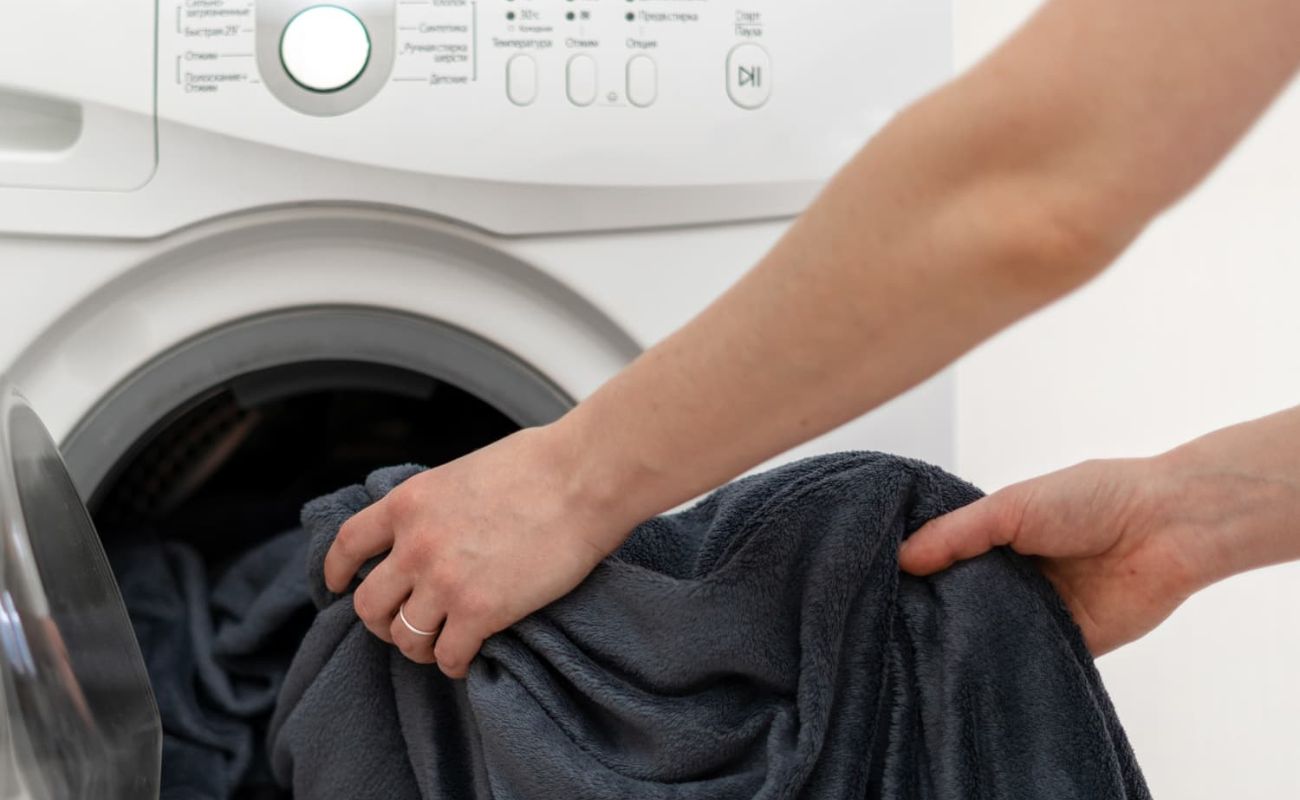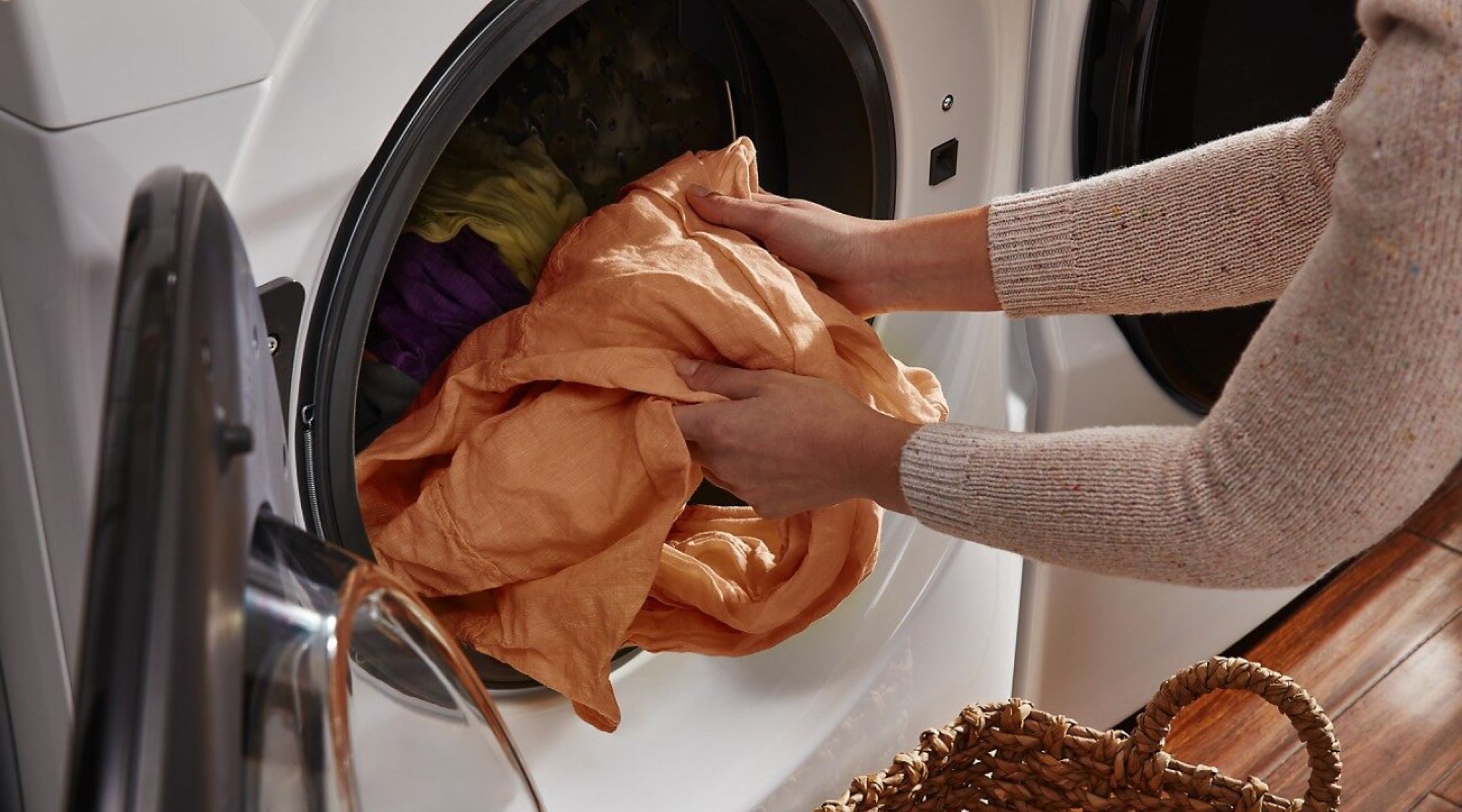

Articles
How To Fix A Weighted Blanket
Modified: December 7, 2023
Learn how to fix a weighted blanket with these helpful articles. Discover simple solutions and get your blanket back in perfect condition.
(Many of the links in this article redirect to a specific reviewed product. Your purchase of these products through affiliate links helps to generate commission for Storables.com, at no extra cost. Learn more)
Introduction
Welcome to the world of weighted blankets, a popular accessory that has been gaining attention for its potential to promote relaxation and improve sleep quality. Designed to provide deep pressure stimulation, weighted blankets offer a comforting sensation that can alleviate anxiety, calm the nervous system, and aid in achieving a more restful sleep. While these blankets are known for their numerous benefits, they are not immune to wear and tear. In this article, we’ll explore common issues with weighted blankets and provide practical solutions to help extend their lifespan.
Weighted blankets work by distributing weight evenly across the body, which increases the release of serotonin and melatonin, the hormones responsible for regulating sleep. The added weight creates a gentle pressure, similar to a comforting hug, that can help reduce anxiety and improve relaxation. Many individuals find that using a weighted blanket promotes a sense of calmness and helps them fall asleep faster and stay asleep longer.
However, as with any well-loved item, weighted blankets may encounter some issues over time. Loose or bunched fillings, ripped seams, uneven weight distribution, and damaged pockets are common problems that can affect the functionality and comfort of the blanket. Fortunately, most of these issues can be easily fixed at home with a little bit of effort and attention to detail.
In the following sections, we’ll take a closer look at each of these common issues and provide step-by-step instructions on how to assess and fix them. Whether you are a first-time owner of a weighted blanket or have been enjoying its benefits for a while, this guide will help you keep your blanket in optimal condition.
Key Takeaways:
- Weighted blankets, while beneficial, may encounter common issues such as loose fillings and ripped seams. With proper assessment and simple repairs, you can extend the lifespan of your blanket and continue enjoying its therapeutic effects.
- Regular maintenance, including adjusting weight distribution and washing, is crucial for preserving the comfort and functionality of your weighted blanket. By following care instructions and addressing issues promptly, you can ensure a prolonged and soothing experience.
Read more: How To Dry A Weighted Blanket
Understanding Weighted Blankets
Before we delve into the common issues and their solutions, it’s essential to have a basic understanding of how weighted blankets are constructed. A typical weighted blanket is made up of two main components: the outer shell and the interior filling.
The outer shell is typically made of a soft and durable material like cotton, microfiber, or minky fabric. This shell encloses the interior filling and provides a comfortable surface for the user. It is important to choose a high-quality shell material that is both breathable and easy to clean.
The interior filling of a weighted blanket is what gives it its weight. It can be made up of various materials including plastic pellets, glass beads, or even natural materials like rice or beans. These fillings are evenly distributed throughout the blanket and can range in weight from 5 to 30 pounds or more, depending on individual preference.
Weighted blankets come in different sizes and weights to accommodate individuals of varying body sizes and preferences. The general rule of thumb is to choose a blanket that is about 10% of your body weight. For example, if you weigh 150 pounds, a 15-pound blanket would be suitable.
It’s important to note that while weighted blankets can provide many benefits, they are not suitable for everyone. Individuals with certain medical conditions, such as claustrophobia, respiratory problems, or circulation issues, should consult with a healthcare professional before using a weighted blanket.
Now that we have a better understanding of how weighted blankets are designed, let’s explore some common issues that may arise and how to address them effectively.
Common Issues with Weighted Blankets
Despite their benefits, weighted blankets can experience a few common issues over time. Understanding these issues and knowing how to address them can help you prolong the life of your blanket and ensure it continues to provide the desired therapeutic effects. Here are some of the most commonly encountered issues:
- Loose or Bunched Fillings: As the blanket is used and moved around, the fillings inside may shift, causing them to become loose or bunched up in certain areas.
- Ripped Seams: The seams of the blanket may become torn or damaged, leading to exposed fillings and decreased durability.
- Uneven Weight Distribution: Over time, the weight inside the blanket may shift, resulting in an uneven distribution that can affect the blanket’s effectiveness.
- Damaged Pockets: Weighted blankets often consist of smaller pockets that hold the fillings. If these pockets become damaged or torn, the fillings may leak out.
- Washing and Maintaining: Weighted blankets require specific care and maintenance to keep them clean and functional. Improper washing or neglecting regular upkeep can lead to the deterioration of the blanket.
While encountering any of these issues can be frustrating, it’s important to remember that most problems with weighted blankets can be fixed without needing to purchase a new one. In the following sections, we’ll explore each of these common issues in detail and provide you with step-by-step instructions on how to overcome them.
By addressing these issues promptly, you can ensure that your weighted blanket remains in optimal condition, providing you with the desired comfort and therapeutic effects for years to come.
Assessing the Problem
Before jumping into fixing the issues with your weighted blanket, it’s essential to properly assess the problem at hand. Taking the time to identify the specific issue will enable you to choose the most appropriate solution and ensure effective repairs. Here’s a step-by-step guide on how to assess the common problems with your weighted blanket:
- Inspect the blanket: Examine the entire blanket, paying close attention to the seams, pockets, and the distribution of the fillings. Look out for any visible signs of damage, such as rips, holes, or broken stitching.
- Check for loose fillings: Gently shake the blanket to see if you can feel or hear any loose or bunched up fillings inside. Run your hands over the surface to feel for any unevenness or clumping of the filling material.
- Assess weight distribution: Lay the blanket flat on a surface and visually inspect if the weight is evenly distributed. Look for any areas where the blanket seems heavier or lighter than others. You can also use a scale to measure the weight in different sections of the blanket.
- Examine the pockets: If your weighted blanket consists of individual pockets, carefully inspect each pocket for any signs of damage, such as holes or tears. Look out for fillings leaking out of the pockets.
- Consider washing and maintenance: Assess the overall cleanliness and condition of the blanket. Note any stains, odors, or signs of wear and tear that may require attention during the cleaning and maintenance process.
By carefully assessing the problem, you will have a clearer understanding of what needs to be repaired or addressed. This will help you choose the most appropriate solution and ensure that your efforts are focused on fixing the specific issue at hand. Additionally, by taking note of any other maintenance or cleaning requirements, you can ensure that your weighted blanket remains in top-notch condition for continued use.
Now that the problem has been assessed, let’s move on to the next step: fixing loose or bunched fillings in your weighted blanket.
Fixing Loose/Bunched Fillings
If you notice that the fillings inside your weighted blanket have become loose or bunched up in certain areas, don’t worry! This issue is common and can be easily remedied with a few simple steps. Here’s a step-by-step guide on how to fix loose or bunched fillings:
- Spread out the blanket: Lay the weighted blanket flat on a clean and spacious surface, ensuring that it is fully extended.
- Locate the problem areas: Gently run your hands over the surface of the blanket to identify the areas where the fillings are loose or bunched up. You may also notice uneven weight distribution in these areas.
- Shift the fillings: Using your hands or a soft object, such as a foam roller or a pillow, gently redistribute the fillings to even out the weight. Massage the problem areas, pushing the fillings towards the empty spaces to create a more balanced distribution.
- Apply pressure and shake: Once you have shifted the fillings, apply light pressure to the problem areas with your hands. This will help the fillings settle into place. Then, gently shake the blanket to further distribute the fillings evenly.
- Inspect and repeat if necessary: After redistributing the fillings, inspect the blanket to see if the problem areas have been resolved. If you still notice any loose or bunched fillings, repeat the process until the weight distribution is even throughout the entire blanket.
By following these steps, you can effectively fix the issue of loose or bunched fillings in your weighted blanket. Remember to be gentle when handling the blanket and avoid applying excessive force, as this may cause further damage. Taking the time to properly redistribute the fillings will not only improve the overall comfort of the blanket but also ensure that it continues to provide the desired therapeutic effects.
Next, let’s move on to repairing ripped seams in your weighted blanket.
When fixing a weighted blanket, check for any tears or loose stitching and repair them promptly to prevent the beads from spilling out. Use a strong thread and a needle to carefully mend any damaged areas.
Read more: How To Store Weighted Blanket
Repairing Ripped Seams
Discovering a ripped seam in your beloved weighted blanket can be disheartening, but there’s no need to worry. With a little bit of effort and some basic sewing skills, you can easily repair the ripped seam and restore the functionality of your blanket. Here’s a step-by-step guide on how to repair ripped seams in a weighted blanket:
- Gather the necessary supplies: To repair a ripped seam, you will need a needle, thread that matches the color of your blanket, scissors, and pins to hold the fabric in place during sewing.
- Pin the ripped seam: Using the pins, carefully align the edges of the ripped seam, ensuring that they match up perfectly. This will hold the fabric in place during the sewing process.
- Thread the needle: Thread the needle with the matching colored thread and tie a knot at the end to secure it.
- Sew the seam: Starting at one end of the rip, use a basic running stitch or a simple backstitch to sew along the seam, gradually closing the gap. Make sure to sew through both layers of fabric to create a strong and secure seam.
- Knot the thread: Once you reach the end of the rip, tie a secure knot to keep the thread in place. Trim any excess thread.
- Inspect and reinforce if necessary: After repairing the seam, carefully inspect the area to ensure that the rip is fully closed. If you notice any weak spots or areas that may need additional reinforcement, sew over those sections again to strengthen the seam.
By following these steps, you can effectively repair ripped seams in your weighted blanket, restoring its integrity and functionality. While it may seem daunting at first, sewing a simple seam is a skill that can be easily learned with practice. If you’re unsure of your sewing abilities, consider enlisting the help of a friend or seeking guidance from online tutorials.
Now that you’ve learned how to repair ripped seams, let’s move on to the next step: adjusting the weight distribution of your weighted blanket.
Adjusting Weight Distribution
Over time, the weight inside a weighted blanket may shift, resulting in an uneven distribution. This can affect the effectiveness and comfort of the blanket. However, there are simple steps you can take to adjust the weight distribution and ensure that the blanket continues to provide the desired therapeutic benefits. Here’s a step-by-step guide on how to adjust the weight distribution of your weighted blanket:
- Lay the blanket flat: Spread the weighted blanket out on a clean and flat surface, ensuring that it is fully extended and free of any wrinkles or folds.
- Identify the uneven areas: Gently run your hands over the surface of the blanket, paying attention to any areas that feel heavier or lighter compared to the rest of the blanket. These are the areas where the weight distribution is uneven.
- Reposition the fillings: To adjust the weight distribution, you will need to reposition the fillings inside the blanket. Start by shifting the fillings from the heavier areas to the lighter areas. You can do this by gently massaging and pushing the fillings with your hands or using a soft object, like a foam roller or a pillow.
- Roll and shake the blanket: After repositioning the fillings, roll up the blanket tightly from one end to the other, applying light pressure as you go. This helps the fillings settle into their new positions. Once the blanket is rolled, shake it gently to further distribute the fillings and ensure an even weight distribution.
- Unroll and test: After shaking the blanket, unroll it and lay it flat again. Use your hands or a scale to test the weight distribution. If necessary, repeat the process of repositioning and rolling until the weight is evenly distributed throughout the entire blanket.
By following these steps, you can successfully adjust the weight distribution of your weighted blanket, ensuring that the pressure is evenly distributed across your body for optimal comfort and effectiveness. Regularly checking and adjusting the weight distribution will help maintain the integrity and therapeutic benefits of your blanket over time.
Now that you’ve learned how to adjust the weight distribution, let’s move on to the next step: replacing damaged pockets in your weighted blanket.
Replacing Damaged Pockets
If you discover that one or more pockets in your weighted blanket have been damaged or torn, it’s important to address the issue promptly to prevent further damage and maintain the integrity of your blanket. While replacing damaged pockets may require a bit more effort and skill, it is a manageable task. Here’s a step-by-step guide on how to replace damaged pockets in your weighted blanket:
- Gather the necessary supplies: To replace the damaged pocket, you will need a seam ripper, fabric that matches the original pocket material, a sewing machine or needle and thread, scissors, pins, and iron.
- Remove the damaged pocket: Use a seam ripper to carefully remove the damaged pocket from the blanket, making sure to avoid damaging the adjacent pockets or seams.
- Prepare the replacement fabric: Measure and cut a piece of replacement fabric that matches the size and shape of the original pocket. Ensure that the fabric is similar in weight and durability to maintain the overall balance of the weighted blanket.
- Secure the replacement fabric: Using pins, attach the replacement fabric to the empty space left by the removed pocket. Make sure to align the edges of the replacement fabric with the surrounding pockets.
- Sew the replacement pocket: Using a sewing machine or needle and thread, sew along the edges of the replacement fabric, carefully attaching it to the blanket. Use a straight stitch or a zigzag stitch for added durability.
- Trim excess fabric: Trim any excess fabric from the replacement pocket, ensuring that it blends seamlessly with the rest of the blanket. Be careful not to cut through any adjacent pockets or seams.
- Iron and inspect: Iron the newly replaced pocket to ensure it lies flat and matches the surrounding pockets. Inspect the work to ensure that the replacement pocket is securely attached and blends in with the rest of the blanket.
By following these steps, you can successfully replace damaged pockets in your weighted blanket, preserving its functionality and aesthetic appeal. It’s important to approach this task with patience and precision to ensure a seamless integration of the replacement pocket with the rest of the blanket. If you’re unsure of your sewing skills, consider seeking assistance from a professional seamstress or tailor.
Now that you’ve learned how to replace damaged pockets, let’s move on to the next step: washing and maintaining your weighted blanket.
Washing and Maintaining a Weighted Blanket
Properly washing and maintaining your weighted blanket is essential to keep it clean, fresh, and in optimal condition. While the specific care instructions may vary depending on the material and filling of your blanket, there are some general guidelines to follow. Here’s a step-by-step guide on how to wash and maintain a weighted blanket:
- Check the care instructions: Before proceeding with any cleaning method, check the care instructions provided by the manufacturer. This will ensure that you follow the recommended cleaning process specific to your weighted blanket.
- Spot clean as needed: For small stains or spills, it’s best to spot clean the affected area immediately. Use a mild detergent or stain remover and a clean cloth or sponge to gently dab the stain. Avoid rubbing vigorously, as it may damage the fabric or spread the stain further.
- Machine washing: If your weighted blanket is machine washable, use a gentle cycle with cold or lukewarm water. Add a mild detergent and avoid using bleach or fabric softener, as these can damage the fabric and fillings. Ensure that the blanket has ample space in the machine to move freely. Once the wash cycle is complete, remove the blanket promptly.
- Hand washing: If the care instructions recommend hand washing, fill a large basin or bathtub with cold or lukewarm water and a mild detergent. Gently agitate the blanket in the soapy water, taking care not to twist or wring it. Drain the water and rinse the blanket thoroughly with clean water until no detergent residue remains.
- Drying: For machine washable blankets, it’s generally recommended to air dry them. Lay the blanket flat on a clean, dry surface or hang it over a clothesline or drying rack. Avoid exposing it to direct sunlight or high heat, as this may cause shrinkage or damage. If possible, periodically flip the blanket over to ensure even drying. Hand-washed blankets should also be air dried in a similar manner.
- Maintaining: To maintain your weighted blanket’s longevity, regularly fluff and rotate it to prevent the fillings from settling or clumping in certain areas. Avoid placing heavy objects on top of the blanket when it’s not in use, as this can cause unnecessary compression. If there are removable covers, follow the care instructions for washing or spot cleaning them separately.
By following these steps, you can effectively wash and maintain your weighted blanket, keeping it clean and in optimal condition for continued use. Always refer to the specific care instructions provided by the manufacturer to ensure the best possible care for your particular blanket.
Now that you’ve learned how to wash and maintain a weighted blanket, let’s conclude our comprehensive guide.
Read more: What Is A Weighted Blanket?
Conclusion
Weighted blankets offer a plethora of benefits, from promoting relaxation and reducing anxiety to improving sleep quality. However, like any well-loved item, they can encounter common issues over time. Fortunately, most of these issues can be addressed and resolved at home, allowing you to extend the lifespan of your weighted blanket and continue enjoying its therapeutic effects.
In this comprehensive guide, we explored the common issues that can arise with weighted blankets, including loose or bunched fillings, ripped seams, uneven weight distribution, damaged pockets, and the importance of washing and maintaining your blanket. We provided step-by-step instructions on how to assess the problems, fix loose or bunched fillings, repair ripped seams, adjust weight distribution, replace damaged pockets, and properly wash and maintain your blanket.
By following these guidelines and taking proactive measures, you can keep your weighted blanket in optimal condition for an extended period. Regularly inspecting and addressing any issues that arise will help ensure the blanket continues to provide the desired comfort and therapeutic benefits.
Remember to refer to the specific care instructions provided by the manufacturer, as each weighted blanket may have unique requirements. Additionally, if you are unsure or uncomfortable with performing any repairs or maintenance yourself, consider seeking assistance from professionals who specialize in blanket care and repair.
With proper care and attention, your weighted blanket can continue to be a source of comfort and relaxation, providing you with a serene and restful sleep experience. So, don’t let these common issues discourage you. Embrace the opportunity to prolong the life of your weighted blanket and continue enjoying its soothing benefits for years to come.
Frequently Asked Questions about How To Fix A Weighted Blanket
Was this page helpful?
At Storables.com, we guarantee accurate and reliable information. Our content, validated by Expert Board Contributors, is crafted following stringent Editorial Policies. We're committed to providing you with well-researched, expert-backed insights for all your informational needs.














0 thoughts on “How To Fix A Weighted Blanket”